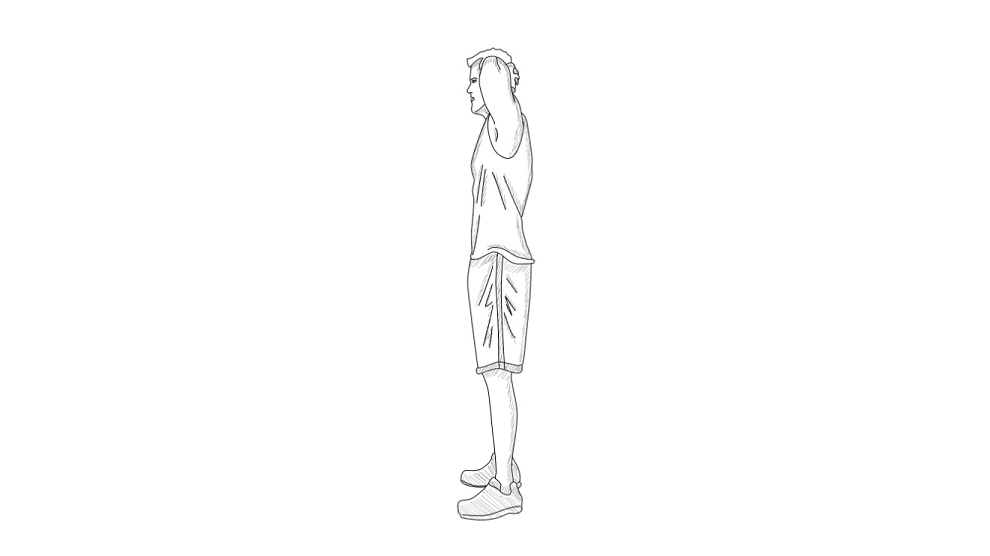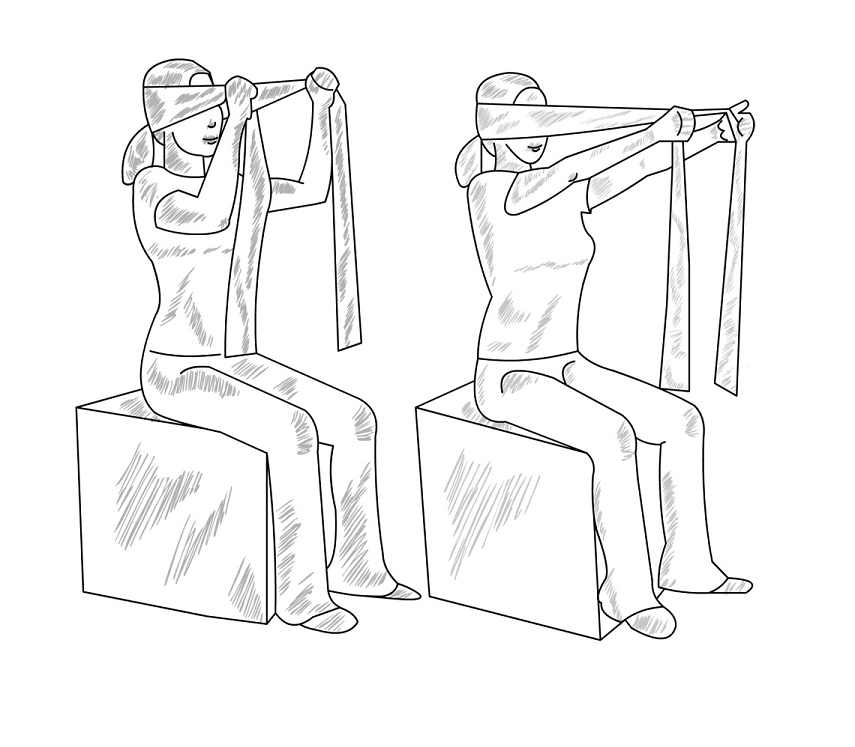In-Line Posture
There might not seem to be a strong connection between body posture and other chronic conditions, but you will soon realize the body’s systems are incredibly intertwined.
The chronic stress response affects posture, and conversely posture affects the chronic stress response. For that reason focusing on improving your posture is a great way to reduce Neuro-Imbalance, which is why it’s included in the DICE protocol.
Good posture stimulates the parasympathetic (recovery and healing) part of the nervous system, which reduces the release of stress hormones and promotes the release of growth and repair hormones including testosterone.* Good posture also affects the other parasympathetic responses like digestion, reduced blood pressure, improved mood, and others. In addition to these positive side effects, good posture has an especially strong effect on breathing. Bad posture not only sends signals to the brain that promote short shallow breaths, the hunched over position of bad posture physically limits your ability to take deep, full breaths. Good posture allows you to use your diaphragm to breathe more deeply and get more oxygen into your body.
What Does Good Posture Look Like?
Our bodies were designed to move efficiently. Posture is the body’s attempt to keep us upright in the strongest, most stable and efficient way possible. Because every person is unique, good posture varies from person to person. Despite these differences there are some characteristics that everyone with good posture will share.
We are all designed to have our ankles, knees, hips, shoulders, and ears roughly lined up vertically. This probably comes as no surprise to you. We all instinctively know what good posture looks like. (It’s one of the major ways we subconsciously interpret attractiveness.) The problem is that few of us have a realistic view of our own posture.

Exercises for Good Posture
Pelvic Rotations with Wall
- Stand with your back against a wall. Your heels should be a foot away from the wall and your knees should be straight but not fully locked out.
- Your buttocks, shoulders, and the back of your head should all be pressed against the wall. If you can’t get your shoulder and head against the wall at the same time don’t worry, this exercise should help with your head-forward posture. In the meantime keep your shoulders against the wall and look straight ahead with your head level.
- Relax your arms so that your hands are at your sides. Move your hands a few inches away from your body, and press the back of your hands into the wall.
- While keeping your knees extended (straight), breathe in and arch your back as slowly as you can. Keep your buttock, shoulders, and head against the wall.
- When your back is arched as much as possible, start breathing out while slowly pressing the small of your back against the wall. Get your low back as close to the wall as possible by trying to pull your belly button in toward the wall. You will have to flex your abdominals to do this properly. (Note that your buttocks may move away from the wall, which is fine).
- Repeat this forward and backward rotation of the pelvis five times. It is important that you do this as slowly as possible and focus on how it feels. Doing this exercise slowly teaches you how to consciously control some of the posture muscles you subconsciously use all the time.

This exercise should be done daily. Good posture is built from the ground up. The only way to eliminate head-forward posture, and the discomfort and pain it causes, is to remove the excess curvature of the lower back. Only when the excess curvature of the lower back is reduced can the other exercises presented below start bringing your head back into alignment.
Head Back
This is one of the simplest exercises for good posture.
- Clasp your hands behind your head (interlocking your fingers).
- While looking straight ahead, cup the back of your head with your clasped hands.
- Keep your elbows wide and back.
- Try to push your head back while resisting that movement with your clasped hands.
- Hold the pressure for five seconds and then release for five seconds. Repeat three times.

When doing this exercise, move your head back with slow steady pressure—no jerking or straining. And exert only as much pressure against your hands as is comfortable (Novak 2006, 24).
Good-Morning Stretch
Despite its name, this quick stretch can be done any time of day. Here’s how.
- Stand tall with your best posture, and look straight ahead with your arms at your side.
- Begin to look upward as you take a deep breath.
- As you begin to breathe in, lift your arms in a circular motion from your sides until they meet above your head (like you are making a snow angel).
- Time your breathing so that you have taken in as much air as you can when your hands meet above your head. When your lungs are full, you should be looking up as much as is comfortable, and your hands should be together or slightly crossing one another.
- Now slowly exhale while you lower your arms to your side and your head goes back to level.
- Repeat this exercise five times.
This is one of our favorite exercises because it includes both a posture exercise and a breathing exercise (Adams 2011). That means fewer exercises to worry about throughout the day. Make this part of your daily routine.
Wall W’s
This is a simple but powerful exercise that fires up the PMRF and gets your brain to start sending good posture signals to your back and neck muscles.
- Stand with your back flat against a wall. (Your knees should be bent to achieve this.)
- Hold your arms up like a football referee signaling a touchdown, then bend your elbows to the level of your shoulders.
- Rotate your palms forward and fingers backward.
- Now press your elbows and fingers against the wall behind you squeezing your shoulder blades together.
- Hold this position for three seconds.
- Bring your hands in front of you, maintaining the elbow position.
- Repeat the process ten times.

With this exercise you want to focus on squeezing your shoulder blades together. Also be sure to keep your head level, the back of your head against the wall, and your pelvis tucked under so that your low back is as flat against the wall as possible. If you have severe head-forward posture and cannot get or keep the back of your head against the wall, hold your head back as far as you can without pain. (Don’t look up and tilt your head back to get it close to the wall; it’s important that your head remains level, eyes looking forward.)
Shoulder-Blade Squeeze
The rhomboids are muscles that attach your shoulder blade to your spine. In a healthy person with good posture, the rhomboids keep the shoulders opened up and prevent them from rolling toward the front. If you have lost the muscle tone that keeps your shoulders back, this exercise will help you strengthen those muscles (Novak 2006, 32).
- Start by grasping the band with each hand. There should be eight inches of band between each hand.
- Hold your hands in front of you. Keep your elbows bent at a ninety-degree angle.
- While keeping your elbows up and your hands level with your armpits, pull your elbows backward like you are squeezing something between your shoulder blades.
- With your shoulder blades squeezed together and your elbows still at ninety degrees, hold the tension for two seconds, then relax and rest for two seconds.
- Repeat five times.
As you progress in strength, move your hold on the band closer together to decrease the space between each hand and increase the tension.

Head Retractions with Band
This exercise really fires up the PMRF. The name of this exercise is a bit misleading. You aren’t actually going to be moving your head at all. You are simply going to be resisting the forward pressure of the exercise band. This requires that you use the muscles that hold your head back.
- Start by grasping the exercise band with about eighteen inches of band between your hands.
- Move the band that is between your hands behind your head (not your neck).
- With your elbows in front of you, look straight ahead, move your head back attempting to create a double chin, and stretch the band by moving your hands straight out in front of you.
- While slowly moving your hands forward, resist the pressure on your head with your neck muscles. Try to keep your head from moving at all.
- Once your arms are fully extended, slowly retract them back to the starting position. Try not to let any slack get into the band. Even at the starting position, it should still be slightly stretched.
- One repetition should take four seconds. Bring your head forward for two seconds, and retract it for two seconds.
- Repeat ten times.

You can adjust the tension on the band (making this exercise more or less difficult) by increasing or decreasing the space between your hands.
The following exercises are
taken from our book,
“Say Goodbye to Back Pain”

